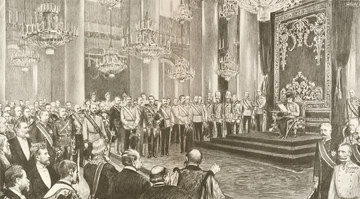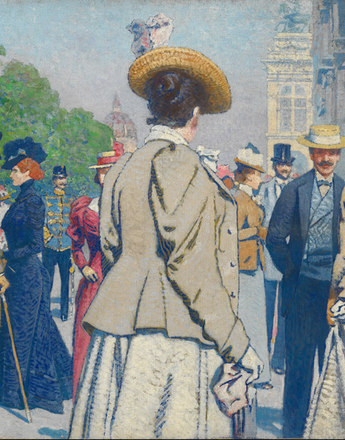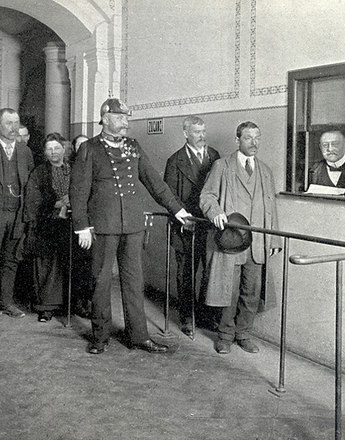On the eve of the First World War the fight for a political voice was by no means over. In the Austrian half of the empire all male citizens had had the vote since 1907, whereas in Hungary it was still only the moneyed classes. Women in both halves of the empire had no political say whatsoever.
The census suffrage in force at the start of parliamentarianism reflected the flagrant social and economic inequality in the strictly hierarchical class society. As participation in political life was linked to tax contributions and education, parliamentarianism was initially a matter for the economic and social elites.
In the Habsburg Monarchy social inequalities in political life were also linked to ethnic origin. There was a marked difference between the dominant nationalities (particularly the Germans and Magyars) and the others, which were effectively excluded from decision-making processes and also lagged behind in most cases in economic development. The distorted representation of ethnic groups was also a result of the organization of the electoral constituencies. The Germans required 37,000 votes for a seat, for example, whereas 95,000 were needed in the constituencies dominated by Ruthenians.
This imbalance was most marked in Transleithania. The Hungarian Reichstag was able to operate effectively only if the political rights of other nationalities were suppressed. The parliament in Budapest remained an exclusive club for the Magyar elite, which retained suffrage based on tax contributions right until the end of the Monarchy and granted political representation only to moneyed classes. In 1913 only 7.7 per cent of the population of the Hungarian half of the empire had the vote. The mass of petty bourgeois, peasants and farm workers and the urban proletariat had no political voice. Given the structure of Hungarian society, in which membership of the educated and moneyed class was synonymous with support of Magyardom, the non-Magyar language groups, which had only very weak economic elites, did not have parliamentary representation commensurate with their populations.
Election reforms in Cisleithania gradually enabled wider sections of the population to participate in political life, which had a marked effect on the political system. The final step from elite to mass participation took place in 1906/07 with the introduction of universal, equal and free suffrage for men. The hope that this would bring about a reform of the antiquated political system was not fulfilled, however. Against a background of social and ethnic conflict, the confrontational attitude of the political camps continued to harden.
The instable party system was split not only by ideological differences but also by national antagonisms. The members of parliament saw themselves in the first instance as representatives of their nations rather than of the supranational state. There was no strong imperial party to bridge the national differences, since even the Social Democrats, who were the closest thing to a supranational force, also split ultimately over national differences. In the absence of consensus, parliament was effectively paralyzed of its own accord.
Suffrage for women was also a political issue in the Habsburg Monarchy at the beginning of the twentieth century, albeit to a much lesser extent than in countries like Great Britain. This demand was not met until the complete restructuring of the political framework after 1918.
Translation: Nick Somers
Gogolák, Ludwig: Ungarns Nationalitätengesetze und das Problem des magyarischen National- und Zentralstaates, in: Wandruszka, Adam/Urbanitsch, Peter (Hrsg.): Die Habsburgermonarchie 1848–1918, Band III: Die Völker des Reiches, Wien 1980, Teilband 2, 1207–1303
Rumpler, Helmut: Eine Chance für Mitteleuropa. Bürgerliche Emanzipation und Staatsverfall in der Habsburgermonarchie [Österreichische Geschichte 1804–1914, hrsg. von Herwig Wolfram], Wien 2005
Stourzh, Gerald: Die Gleichberechtigung der Nationalitäten in der Verfassung und Verwaltung Österreichs 1848 bis 1918, Wien 1985
Wandruszka, Adam (Hrsg.): Die Habsburgermonarchie 1848–1918, Band VII: Verfassung und Parlamentarismus. Teil 1: Verfassungsrecht, Verfassungswirklichkeit und zentrale Repräsentativkörperschaften, Wien 2000
-
Chapters
- ‘God preserve Him, God protect Him’ – The Emperor
- The Army: Austria-Hungary in its entirety
- The bureaucracy as the long arm of the state
- The Dual Monarchy: two states in a single empire
- ‘Indivisible and inseparable’ – the supranational state
- The Habsburg Monarchy in the process of democratization
- The absence of political culture
- A strong monarch and autocratic tendencies




